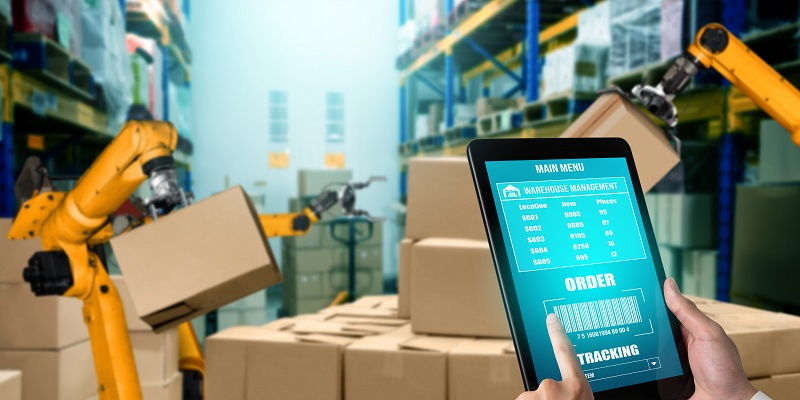In recent years, there has been a significant surge in the development and adoption of mobile robots in the logistics industry. According to IDTechEx’s research, there has been a substantial cumulative increase in funding for various types of mobile robots from 2015 to 2022. This rising interest and investment in mobile robotics underlines the growing recognition of their transformative potential and efficiency in the logistics sector.
Growth and Maturity of Automated Guided Vehicles (AGVs) in Material Transport (2023)
As of 2023, certain applications, such as material transport using automated guided vehicles (AGVs), have already reached a mature stage, attracting billions of dollars in annual revenue. AGVs have proven to be reliable and efficient when it comes to moving goods within warehouses and distribution centers. Their ability to follow pre-defined paths and navigate safely without human intervention has made them crucial assets in optimizing logistics operations.
Rapid growth and acquisitions in various mobile robot segments
One of the notable trends in the mobile robotics industry is the rapid growth experienced across different segments. Despite varying market readiness levels, each segment is witnessing substantial expansion, with instances of technology giants acquiring start-up companies to strengthen their foothold in the market. This signifies the immense potential and attractiveness of mobile robotics in enhancing operational efficiency and cost-effectiveness in logistics.
Overview of Key Products Used in Logistics Operations
IDTechEx’s report examines the key products used in various logistics operations, offering a comprehensive understanding of the evolving landscape. These products include automated guided vehicles (AGVs), autonomous mobile robots (AMRs), case-picking robots, mobile manipulators, heavy load autonomous mobile vehicles (AMVs), and last-mile delivery robots. Each of these technologies serves specific purposes in optimizing logistics processes, and their deployment is increasingly becoming more common.
Impact of Amazon’s autonomous mobile robot, Proteus, on AMR adoption
The report highlights recent technological advancements and commercial transitions within the logistics industry. An example of this is Amazon’s introduction of Proteus, the company’s first fully autonomous mobile robot. Proteus is expected to drive the adoption of autonomous mobile robots (AMRs) in warehouses, accelerating the automation revolution in logistics. This development not only showcases the influence of industry giants but also indicates the potential domino effect it can have on the wider market.
In-depth Technology Analysis of Emerging Technologies in Mobile Robotics
To gain deeper insights into the growth of mobile robots, IDTechEx analyzed the teardown components of various mobile robots. This approach offers an in-depth technology analysis of emerging technologies that underpin the growth of mobile robots. By understanding the core components and functionalities of these robots, researchers can anticipate future advancements and improvements that will further revolutionize the logistics industry.
Transitioning from AGVs to AMRs for More Operational Flexibility
One of the transitions observed by IDTechEx is the shift from automated guided vehicles (AGVs) to autonomous mobile robots (AMRs) in manufacturing facilities and warehouses. While AGVs have showcased their efficacy in defined environments, AMRs offer more flexibility in operation. AMRs can adapt to changing layouts, alter their routes, and handle dynamic tasks. This transition is driven by the need for enhanced adaptability and efficiency, which is vital for today’s dynamic and evolving logistics operations.
Comprehensive 20-year market forecasts for mobile robotics in the logistics industry
The IDTechEx report provides 20-year market forecasts for the future of mobile robotics in the logistics industry. These forecasts offer valuable insights and projections for industry stakeholders. The market forecasts include granular breakdowns by application area and product categories, enabling businesses and investors to make informed decisions and capitalize on the growth opportunities presented by mobile robotics.
There are significant opportunities for component suppliers, robot OEMs, and end-users in the market
Through IDTechEx’s research, it is predicted that the yearly market size of mobile robots, excluding L4 trucks, will reach around US$150 billion. This represents significant opportunities for component suppliers, robot original equipment manufacturers (OEMs), and end-users. The growing demand for mobile robots in logistics opens avenues for innovation, collaboration, and development within the industry. Component suppliers can cater to the demand for advanced technologies, while robot OEMs can enhance their product offerings. On the other hand, end-users can leverage the benefits of automation to streamline their logistics operations and gain a competitive edge.
Discussion of technical, regulatory, and market influences on the logistics mobile robot industry
The IDTechEx report also delves into the key factors influencing the emerging logistics mobile robot industry. These include technological advancements, regulatory considerations, and market dynamics. Technological developments drive the evolution of mobile robotics, while regulations play a crucial role in ensuring safety and compliance. Additionally, market forces such as customer expectations, competition, and cost-efficiency shape the direction and growth of the industry. Understanding these influences is crucial for industry players to navigate the evolving landscape successfully.
The mobile robotics industry in the logistics sector is experiencing substantial growth and transformation. From increased funding to the maturity of certain applications, the potential of mobile robots in revolutionizing logistics operations is being realized. With the emergence of advanced technologies such as AMRs and the influence of industry giants like Amazon, the future of mobile robotics in logistics looks promising. By staying attuned to technological advancements and market trends, businesses and investors can harness the immense opportunities this sector presents and thrive in the era of automation and optimization.

